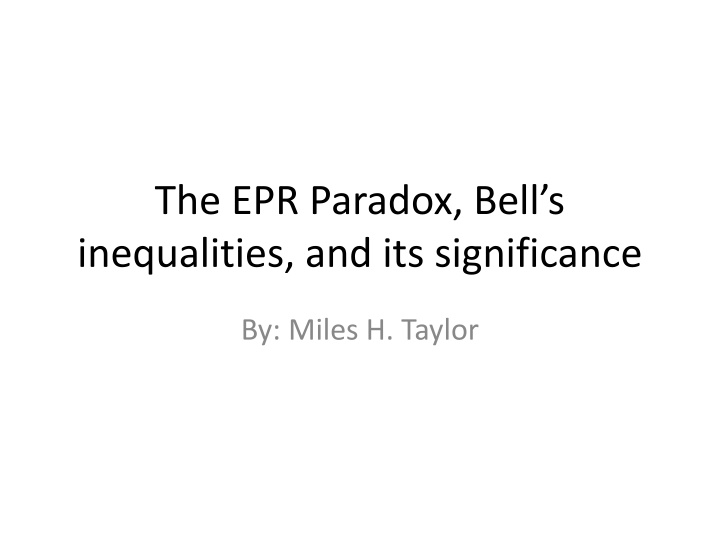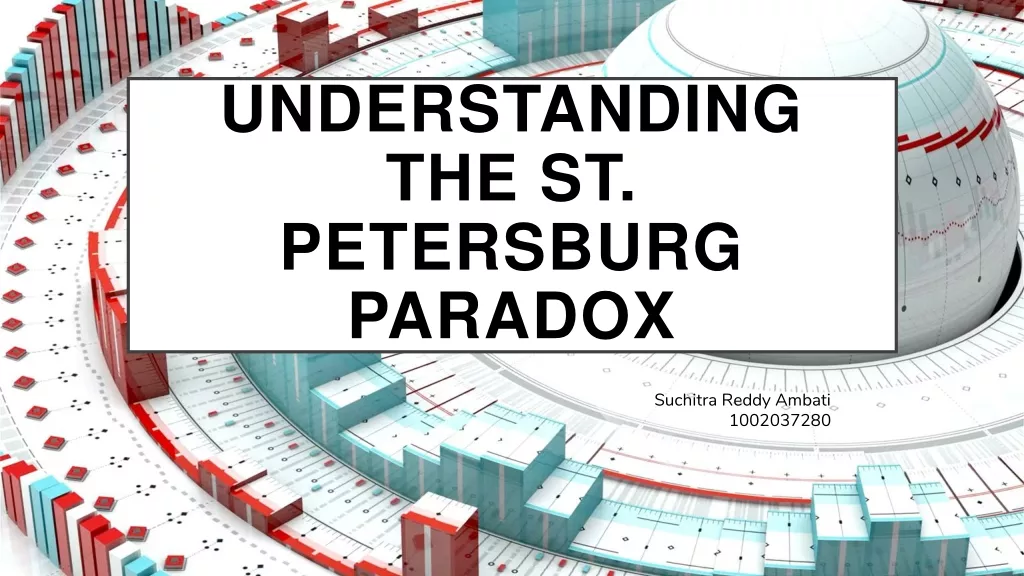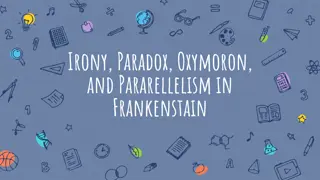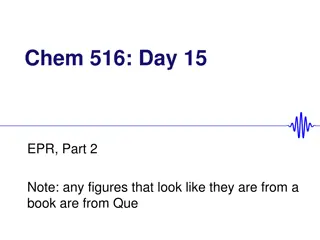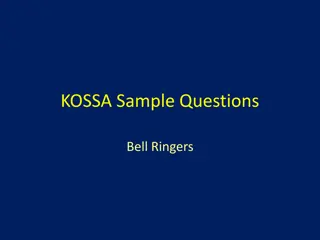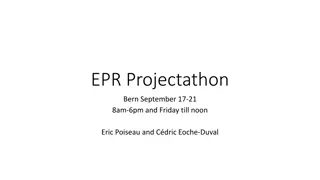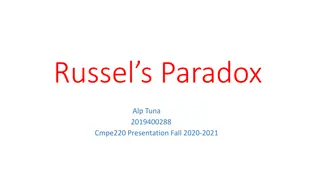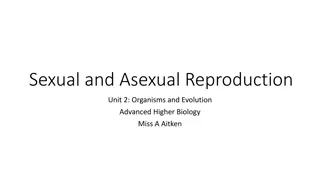Unveiling the Significance of the EPR Paradox and Bell's Inequalities
Physicists Albert Einstein, Boris Podolsky, and Nathan Rosen introduced the EPR paradox in 1935 to challenge the completeness of quantum mechanics through a thought experiment, highlighting issues in quantum entanglement and observable properties. Bohr's reaction emphasized the incompatibility of EPR's reasoning with quantum mechanics. Bell's Inequalities further refuted local variable theories favored by EPR, providing a mathematical framework to demonstrate the non-local behavior of entangled systems.
Download Presentation

Please find below an Image/Link to download the presentation.
The content on the website is provided AS IS for your information and personal use only. It may not be sold, licensed, or shared on other websites without obtaining consent from the author.If you encounter any issues during the download, it is possible that the publisher has removed the file from their server.
You are allowed to download the files provided on this website for personal or commercial use, subject to the condition that they are used lawfully. All files are the property of their respective owners.
The content on the website is provided AS IS for your information and personal use only. It may not be sold, licensed, or shared on other websites without obtaining consent from the author.
E N D
Presentation Transcript
The EPR Paradox, Bells inequalities, and its significance By: Miles H. Taylor
The EPR Paradox In 1935, physicists Albert Einstein, Boris Podolsky, and Nathan Rosen created a thought experiment that was supposed to show a lack of completeness in quantum mechanics, a relatively recent creation at the time. The thought experiment, later called the EPR paradox after the last names of the creators, was based upon a paradox they saw in the quantum entanglement idea of quantum mechanics regarding the fact that one cannot know observables from different sets. They began by imagining two physical systems that interact when created, so that they will be defined by a single quantum state (Blanton). In other words, one must begin by imagining two entangled particles. Even when separated, the two systems will still be described by the same wave function, no matter the distance between them, as they are still entangled. If someone measures an observable, such as the spin if the systems are photons, of one system, it will immediately determine the measurement of the corresponding observable in the second system (Blanton). This applies even at distances that special relativity should prohibit. Imagine that the two systems are light-years apart. According to quantum mechanics, measuring an observable in the first system forces the corresponding observable in the other system into a well-defined state immediately, despite the fact that they are not close enough to have an effect on one another. The information between the two has passed much too fast for the distance under the theory of relativity. This left two options for Einstein, Podolsky, and Rosen to reconcile this issue. The first was to accept the statements of quantum mechanics as unquestionable facts, or to accept that quantum mechanics was not complete yet and was still missing pieces of information. The second option meant that there was more information available for the two systems at the beginning, but it was not available because either it could not be known or quantum mechanics was not complete. Using this idea, Einstein, Rosen, and Podolsky proposed that hidden variables existed (Blanton). These hidden variables were just unknown properties of the systems that should account for the discrepancy (Blanton).
Bohrs reaction it is not allowed in quantum mechanics to make the type of reasoning proposed by Einstein, Podolsky and Rosen, and more specifically, the notion of element of reality does not make sense for quantum mechanical entities"
Bells Inequalities Ruled out the local variable theory EPR liked The inequality was thus: Number (A, not B) + Number (B, not C) is greater than or equal to Number (A, not C) (Harrison). The proof to this goes as such when n stands for number: n(A, not B, C) + n(not A, B, not C) 0 then: n(A, not B, C) + n(not A, B, not C) + n(A, not B, not C) + n(A, B, not C) 0 + n(A, not B, not C) + n(A,B, not C) which changes to: n(A, not B, C) + n(not A, B, not C) + n(A, not B, not C) + n(A, B, not C) n(A, not C) since for all members either B or not B must be true (Harrison). This can further be simplified to: n(A, not B) + n(not B, not C). Applying this to electron spin, where A: electron spin up at an angle of 0 degrees, B: electron spin up for an angle of 45 degrees, and C: electron spin up at 90 degrees, the following occurs: n(spin-up zero degrees, not spin-up 45 degrees) + n(spin-up 45 degrees, not spin- up 90 degrees) n(spin-up zero degrees, not spin-up 90 degrees) (Harrison).
Secure quantum codes E91 principle Alice creates a pair of entangled photons. According to Bell s theorem and inequality, as mentioned earlier, entangled quantum states will keep the characteristics of being entangled, even when separated. To start the creation, Alice or a trusted third party creates a pair of entangled photons. The pair is then separated so that Alice and Bob each receive one photon of the pair. Alice and Bob then separately choose from two different orientations of their analyzers to measure the polarizations. After a set amount, the results are separated into two groups. The first is when different orientations are used, and the second is when the same orientation is used (Cobourne)
FTL Communication The fact that it appears EPR interacts badly with SR opens up the possibility of instant information, if it were possible to send entangled photons far enough No true information can be passed according to studies by Alan Aspect, and two by Nicolas Gisin.
Questioning SR Because both parts of quantum and SR are experimentally confirmed with some accuracy, there is much debate over which should rule the other in this case. Recent studies have shown that it appears QM makes a better prediction, but research is ongoing.
Solutions While Bell ruled out local theories, some physicists still believe in it Others believe in exotic non-local theories in which the properties are not near the the photons Many physicists follow the Copenhagen interpretation, that there are no hidden properties whatsoever, and that QM overrules SR in this case.
